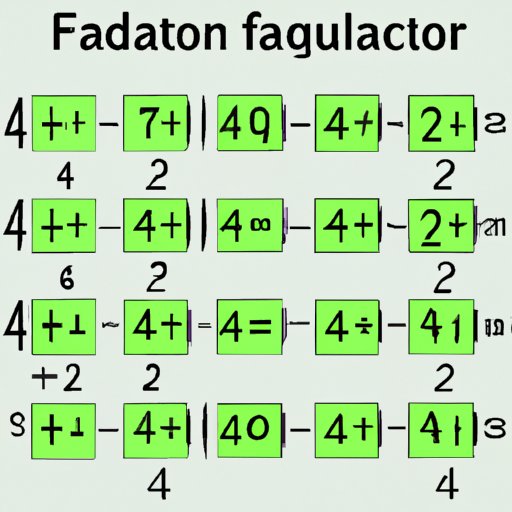
I. Introduction
Factoring is an essential aspect of algebra and advanced maths. It is the process of breaking down a polynomial equation into simpler parts, making it easier to solve. Factoring is crucial in solving algebraic equations, quadratic equations, and other high-level equations, making it a vital concept to master.
The purpose of this article is to provide readers with a comprehensive guide to factoring expressions. The guide will cater to all levels of mathematics students, from beginners to advanced learners.
II. Step-by-Step Guide
Factoring an expression involves several steps, and it can be challenging for students who are new to the concept. The first step is to identify the terms in the polynomial equation.
Next, it is crucial to look for the greatest common factor and factor it out. For example, the equation 3x^3 + 6x^2 + 3x can be factored into 3x(x^2 + 2x + 1).
The next step is to examine the expression, determine the type of pattern it follows, and factor it accordingly. For example, the equation x^2 – y^2 can be factored into (x + y)(x – y).
It can be complicated to spot the pattern or technique required to factor an expression accurately. Therefore, it is essential to practice and become familiar with the process.
III. Visual Guide
Some students may benefit from visual aids to understand factoring expressions. Diagrams, images, and videos are excellent tools for visual learners. They can provide a clear representation of the steps involved in factoring an expression.
Videos can break down the process further, with instructors recounting the formula step by step. YouTube channels such as Khan Academy and Math Antics offer comprehensive visual aids for students attempting to learn factoring expressions.
IV. Practical Examples
Factoring expressions can prove valuable in real-world applications in fields such as finance, physics, and engineering. For example, a finance analyst may use factoring expressions to calculate interests on loans.
Engineers may use factoring expressions to analyze complex data sets and identify solutions for technical issues. Physics students may use factoring expressions to calculate the motion of objects.
Students may struggle to understand the importance of factoring expressions. However, mastering the concept can help them navigate their professional lives by preparing them to tackle real-world problems, no matter their field of study.
V. Common Misconceptions
Factoring expressions can be a difficult concept to understand, leading to numerous misconceptions among students. One common misconception is that factoring is only essential in algebra. However, factoring is crucial in higher levels of mathematics.
Another misconception is that factoring is only necessary for solving quadratic equations. Factoring can be used for cubic, quartic equations, and any other type of polynomial expression. Some students may struggle with the process of factoring trinomials or binomials, leading to additional misconceptions. It is crucial to determine areas where students may struggle and offer solutions.
VI. Importance of Factoring
Mastering factoring expressions is crucial for advanced mathematics such as calculus, trigonometry, and higher levels of algebra. Factoring provides the foundation for other mathematical concepts, making it an integral part of every student’s maths education.
Factoring also has practical applications in numerous fields such as finance, physics, engineering, and computer science. Correctly factoring an expression can lead to faster, more efficient solutions for complex problems.
VII. Factoring in Algebra
Factoring is an integral part of algebraic equations, with numerous algebraic formulas using factoring expressions. It is crucial to master factoring early on in algebra as it paves the way for all other algebraic concepts.
Factoring can be used to solve quadratic equations, cubic equations, and even equations with multiple variables. The more students practice factoring, the more natural it becomes, and they gain the necessary confidence for high-level algebraic equations.
VIII. Factoring Games
Factoring expression can be a challenging concept to understand. However, games, quizzes, and puzzles can make it enjoyable. Incorporating interactive quizzes or challenges into the classroom can engage students and encourage them to practice.
Online resources such as Math Play and Learning Games for Kids offer interactive puzzles and games that make learning fun. Teachers can use these games to supplement their teaching and help students retain information better.
IX. Conclusion
Factoring expressions are an essential concept that every mathematics student should master. It is integral to algebra, calculus, and higher-level mathematics, making it a crucial stepping stone for many students.
By providing step-by-step guides, practical examples, and visual aids, students can better understand the process of factoring. Quizzes and challenges can make learning about factoring expressions enjoyable while reinforcing learning. With practice, students can master factoring expressions and confidently navigate their mathematical journey.





